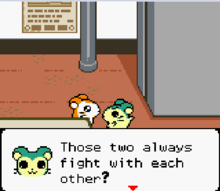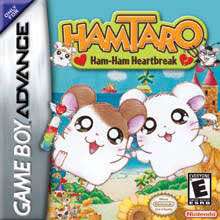Hamtaro (video game series)
| Hamtaro | |
|---|---|
| Genres | Adventure game / Educational game |
| Developers | Shogakukan, Riverdeep |
| Publishers | Shogakukan / Riverdeep |
| Platforms | Game Boy Color, Game Boy Advance, Nintendo DS |
| Platform of origin | Game Boy Color |
| First release |
Tottoko Hamtaro: Tomodachi Daisakusen Dechu
|
| Latest release |
Hamtaro: Little Hamsters, Big Adventures
|
Hamtaro is a series of video games based on the Hamtaro anime series.
Games
Tomodachi Daisakusen Dechu
Tottoko Hamtaro: Tomodachi Daisakusen Dechu (とっとこハム太郎: ともだち大作戦でちゅ) was released in Japan for the Game Boy Color in 2000.
Ham-Hams Unite!
| Hamtaro: Ham-Hams Unite! | |
|---|---|
 | |
| Developer(s) | Pax Softnica |
| Publisher(s) | Nintendo |
| Director(s) | Mariko Yumoto |
| Producer(s) |
Shigeru Miyamoto Kenji Miki Masahiro Tatemoto |
| Composer(s) | Satoko Yokota |
| Platform(s) | Game Boy Color |
| Release date(s) | |
| Genre(s) | Adventure |
| Mode(s) | Single-player |
Hamtaro: Ham-Hams Unite! (とっとこハム太郎2 ハムちゃんず大集合でちゅ Tottoko Hamutarou 2 - Hamu-chanzu Daishuugou Dechu) is a Hamtaro adventure video game developed by Pax Softnica and published by Nintendo for the Game Boy Color handheld video game console. It was first released in Japan on April 21, 2001, and was later released in North America on October 28, 2002, and in Europe on January 10, 2003. It was the last game officially released for the Game Boy Color in Europe.

| Reception | ||||||||||||||||||||||
|---|---|---|---|---|---|---|---|---|---|---|---|---|---|---|---|---|---|---|---|---|---|---|
| ||||||||||||||||||||||
The player (Hamtaro) is controlled by the D-pad, and holding down the B button allows the player to run. Pressing A will open a dialogue box with different Ham-chat words depending on context. For instance, standing next to a sunflower seed and selecting "hif-hif" will pick up the seed, while standing next to an NPC and selecting "Hamha" will open a dialogue with the character. Different options will yield different outcomes, rolling (Tack-Q) into NPCs will usually elicit a negative response. Objects in the world can be interacted with, like climbing trees and pulling drawers open.
The player enters the Clubhouse and is directed by the Boss to round up the other hamsters.
Ham-Ham Heartbreak
| Hamtaro: Ham-Ham Heartbreak | |
|---|---|
 | |
| Developer(s) | Pax Softnica |
| Publisher(s) | Nintendo |
| Director(s) | Mariko Yumoto |
| Producer(s) |
Shigeru Miyamoto Kenji Miki Masahiro Tatemoto |
| Writer(s) | Ritsuko Kawai |
| Composer(s) | Satoko Yokota |
| Platform(s) | Game Boy Advance |
| Release date(s) | |
| Genre(s) | Adventure game |
| Mode(s) | Single player |
Hamtaro: Ham-Ham Heartbreak (とっとこハム太郎3 ラブラブ大冒険でちゅ Tottoko Hamutaro 3: Love Love Daibōken Dechu) is a video game for Game Boy Advance developed by Pax Softnica and published by Nintendo, as the sequel to Tottoko Hamutaro: Tomodachi Daisakusen Dechu and Hamtaro: Ham-Hams Unite!. Therefore, it was the second Hamtaro game released in America and Europe, but the third one in Japan. It was released in Japan on May 3, 2002, in North America on April 8, 2003 and in Europe on June 27, 2003. After Hamtaro: Ham-Ham Heartbreak, only one more Hamtaro adventure game was released, which was Hamtaro: Rainbow Rescue.
Like its predecessors, Hamtaro: Ham-Ham Heartbreak is an adventure game. Set in the world of the Hamtaro books and anime, the player controls the hamster ("Ham-Ham", as the hamsters tend to call themselves) Hamtaro. The game expands on the gameplay of the earlier titles by adding Bijou, a friend of Hamtaro who has a crush on him, as partner. Together, they have to save the other ham-hams from Spat, an evil hamster with a hatred for any kind of relation.
Wake Up Snoozer!
| Hamtaro: Wake Up Snoozer! | |
|---|---|
 American art front cover | |
| Developer(s) | ShoPro Entertainment |
| Publisher(s) | Riverdeep |
| Distributor(s) | The Learning Company |
| Platform(s) | Microsoft Windows, Mac OS |
| Release date(s) | 2003 |
| Genre(s) | Educational game |
| Mode(s) | Single-player |
Hamtaro: Wake Up Snoozer! is a 2003 educational game for Microsoft Windows and Mac OS. Hamtaro: Wake Up Snoozer! is a video game similar to the series Hamtaro. And this is the first (and only) Hamtaro game to be for PC/Macintosh.
Hamtaro and his friends play minigames to wake up Snoozer. The minigames are child-oriented. The game includes special features to work with the Ham-Hams such as: Hamtaro, Bijou, Panda, Howdy, Dexter, Pashmina, Boss, and Oxnard. And options to return to clubhouse, and more.
Rainbow Rescue
| Hamtaro: Rainbow Rescue | |
|---|---|
 | |
| Developer(s) | AlphaDream |
| Publisher(s) | Nintendo |
| Director(s) |
Chihiro Fujioka Takahiro Murakami |
| Producer(s) |
Shigeru Miyamoto Kenji Miki Tetsuo Mizuno |
| Designer(s) |
Jun Iwasaki Hiroshi Kikuchi Masumi Miyano Takeshi Hiraga |
| Composer(s) |
Kiyomi Tanaka Rie Kaneko |
| Platform(s) | Game Boy Advance |
| Release date(s) | |
| Genre(s) | Adventure game |
| Mode(s) | Single player |
Hamtaro: Rainbow Rescue (とっとこハム太郎4 にじいろ大行進でちゅ Tottoko Hamtaro 4: Nijiiro Daikoushin Dechu) is a video game developed by AlphaDream for Game Boy Advance and the sequel to Tottoko Hamutaro: Tomodachi Daisakusen Dechu, Hamtaro: Ham-Hams Unite! and Hamtaro: Ham-Ham Heartbreak. It was released in Japan and PAL regions, and was set to be released in North America, but it was cancelled. The series is based on the manga Hamtaro, written by Ritsuko Kawai.
The game involves an extensive plot. One day while playing outside, Bijou witnesses a great rainbow. The rainbow disappears and Prince Bo falls to the ground. The Prince states that he can make rainbows by using his umbrella. He tries to prove it to disbelieving Stan and the rest of the Ham-Hams, but realizes too late that the colors on his umbrella are gone. And thus, Hamtaro and his Ham-Ham friends must set off on a journey in order to collect things that are the proper color for Prince Bo to use for his umbrella so he can create a rainbow to return home.
Certain minigames are needed to reach the colors, and the player must have certain Ham-Hams in their party in order to play them. For example, Sandy is needed to ride pigeons, Bijou is needed to collect falling petals, and Penelope is needed for rolling on top of cans to get across small streams. In addition to the original Ham-Hams, the game contains some additional characters, most of which were never seen in the English anime. These include Prince Bo, who is the prince of Rainbowland (a castle that is made of clouds); Flora, or Nurse-Ham; Tux; and other various characters.
Ham-Ham Games
|
| |
| Developer(s) | AlphaDream |
|---|---|
| Publisher(s) | Nintendo |
| Director(s) |
Chihiro Fujioka Takahiro Murakami |
| Producer(s) |
Shigeru Miyamoto Kenji Miki Tetsuo Mizuno |
| Designer(s) |
Hiroshi Nonaka Takashi Arai Yuichi Nakagawa Masaki Tanaka Jun Iwasaki |
| Platform(s) | Game Boy Advance |
| Release date(s) | |
| Genre(s) | Sports game |
| Mode(s) | Single-player, multiplayer |
Hamtaro: Ham-Ham Games (とっとこハム太郎 ハムハムスポーツ Tottoko Hamutarou: Hamu-Hamu Sports) is a sports video game developed by AlphaDream and published by Nintendo for the Game Boy Advance handheld video game console. It was released in Japan on July 15, 2004, in Europe on July 16, 2004, and in North America on July 27, 2004.
| Reception | ||||||||||||||||||||||||||||||
|---|---|---|---|---|---|---|---|---|---|---|---|---|---|---|---|---|---|---|---|---|---|---|---|---|---|---|---|---|---|---|
| ||||||||||||||||||||||||||||||
The game received "generally favorable reviews" according to the review aggregation website Metacritic.[8] In Japan, Famitsu gave it a score of one seven, two eights, and one seven for a total of 30 out of 40.[9]
Question Castle in the Clouds
Tottoko Hamtaro: Nazo Nazo Q Kumonoue no ? Jou (とっとこハム太郎 ナゾナゾQ 雲の上の?城), or Tottoko Hamtaro Nazonazo Q: Question Castle in the Clouds, was released for the Nintendo DS in Japan in 2005.
Little Hamsters Big Adventure
| Hi Hamtaro! Little Hamsters Big Adventure | |
|---|---|
 | |
| Developer(s) | AlphaDream |
| Publisher(s) | |
| Platform(s) | Nintendo DS |
| Release date(s) |
|
| Genre(s) | Puzzle |
| Mode(s) | Single-player |
Hi Hamtaro! Little Hamsters Big Adventure (とっとこハム太郎 は~い! ハムちゃんずのハムハムチャレンジ! あつまれは~い! Tottoko Hamutarou Haai! Hamuchanzu no Hamuhamu Charenji! Atsumare Haai!, lit. "Tottoko Hamtaro, Okay! The Hamchans' Ham-Ham Challenge! Let's Get Together, Okay!), known as Hi! Hamtaro Ham-Ham Challenge in North America, is a puzzle game for the Nintendo DS made by AlphaDream and published by Marvelous in Japan, 505 Games in PAL regions, and Natsume in North America. It is a sequel to Hamtaro: Ham-Hams Unite!, Hamtaro: Ham-Ham Heartbreak, Hamtaro: Rainbow Rescue (which was never released in America), Hamtaro: Ham-Ham Games, and the Japan-only Tottoko Hamtaro Nazonazo Q: Question Castle in the Clouds, and is based on the anime series Hamtaro. The game was released in Japan on March 15, 2007, in Europe on May 23, 2008 and in North America on September 23, 2008.
iOS
Hamtaro: Little Hamsters, Big Adventures was released for iOS in 2011.
References
- ↑ "Hamtaro: Ham-Hams Unite! for Game Boy Color". GameRankings. Retrieved February 8, 2015.
- ↑ Tom Bramwell (February 17, 2003). "Hamtaro: Ham-Hams Unite!". Eurogamer. Retrieved February 8, 2015.
- ↑ Bro Buzz (December 2, 2002). "Hamtaro: Ham-Hams Unite! Review for Game Boy Color on GamePro.com". GamePro. Archived from the original on December 9, 2004. Retrieved February 8, 2015.
- ↑ Craig Harris (November 4, 2002). "Hamtaro: Ham-Hams Unite!". IGN. Retrieved February 8, 2015.
- ↑ "Hamtaro: Ham-Hams Unite!". Nintendo Power. Vol. 162. November 2002.
- ↑ Ty Shughart (December 5, 2002). "Hamtaro: Ham Hams Unite". Nintendo World Report. Retrieved February 9, 2015.
- ↑ Miguel Concepcion (December 9, 2002). "'Hamtaro: Ham Hams Unite' (GBC) Review". X-Play. Archived from the original on December 19, 2002. Retrieved February 8, 2015.
- 1 2 "Hamtaro: Ham-Ham Games for Game Boy Advance Reviews". Metacritic. Retrieved February 9, 2015.
- 1 2 "Hamtaro: Ham-Ham Games". Famitsu. 814. July 23, 2004.
- ↑ Rice Burner (August 2, 2004). "Hamtaro: Ham-Ham Games Review for Game Boy Advance on GamePro.com". GamePro. Archived from the original on December 12, 2004. Retrieved February 9, 2015.
- ↑ Theobald, Phil (July 29, 2004). "GameSpy: Hamtaro: Ham-Ham Games". GameSpy. Archived from the original on January 11, 2006. Retrieved February 9, 2015.
- ↑ "Hamtaro: Ham-Ham Games". GamesTM: 114. September 2004. Archived from the original on August 17, 2004. Retrieved February 9, 2015.
- ↑ Hollingshead, Anise (August 1, 2004). "Gamezone Gameboy Reviews - Hamtaro Ham-Ham games". GameZone. Archived from the original on February 3, 2009. Retrieved February 9, 2015.
- ↑ Harris, Craig (July 26, 2004). "Hamtaro: Ham-Ham Games". IGN. Retrieved February 9, 2015.
- ↑ "Hamtaro: Ham-Ham Games". NGC Magazine. September 2004.
- ↑ "Hamtaro: Ham-Ham Games". Nintendo Power. 183: 116. September 2004.
- ↑ Shughart, Ty (September 7, 2004). "Hamtaro: Ham-Ham Games". Nintendo World Report. Retrieved February 9, 2015.
- ↑ "Hamtaro: Ham-Ham Games". The Times. August 14, 2004. Retrieved February 9, 2015.(subscription required)